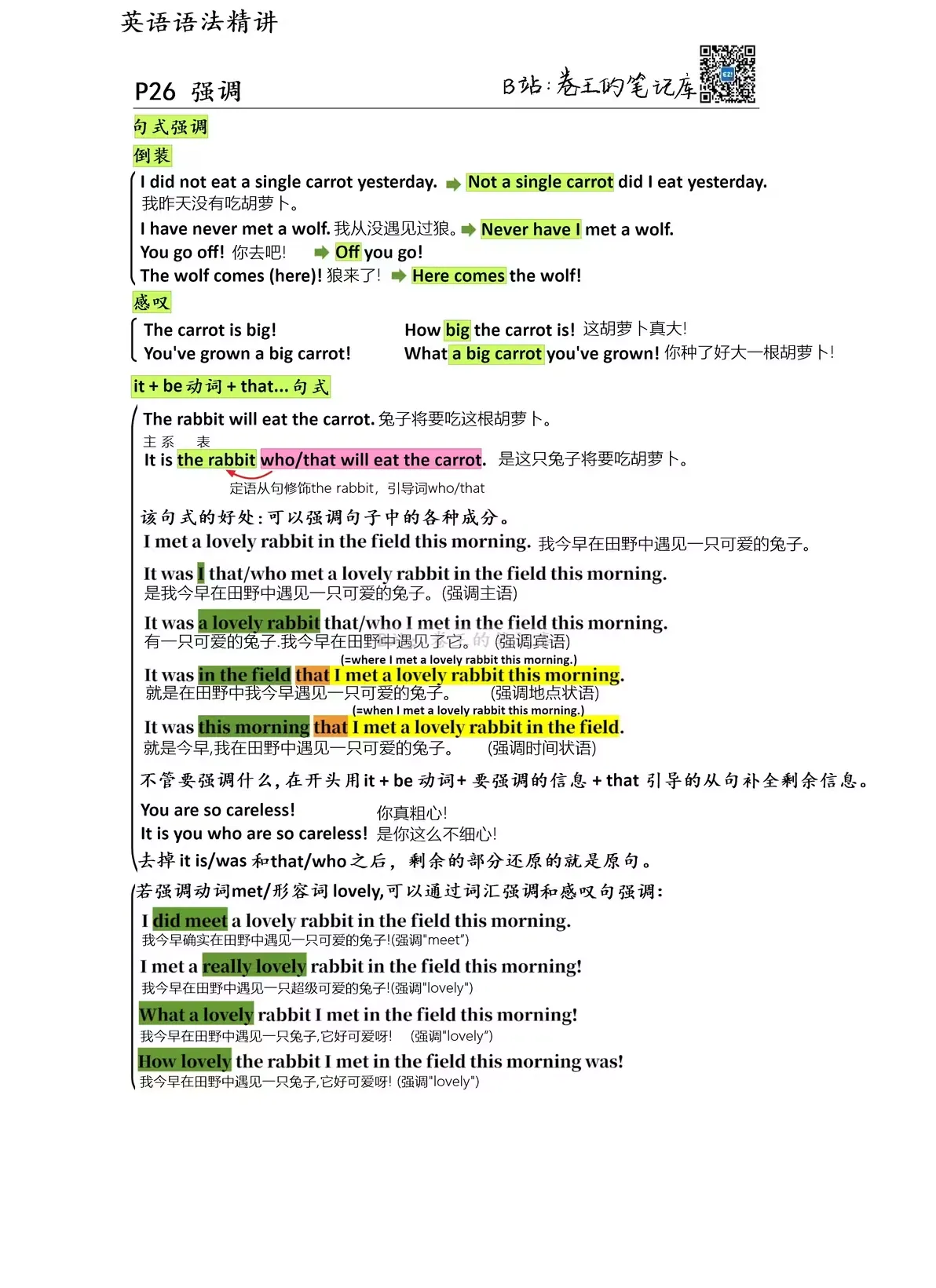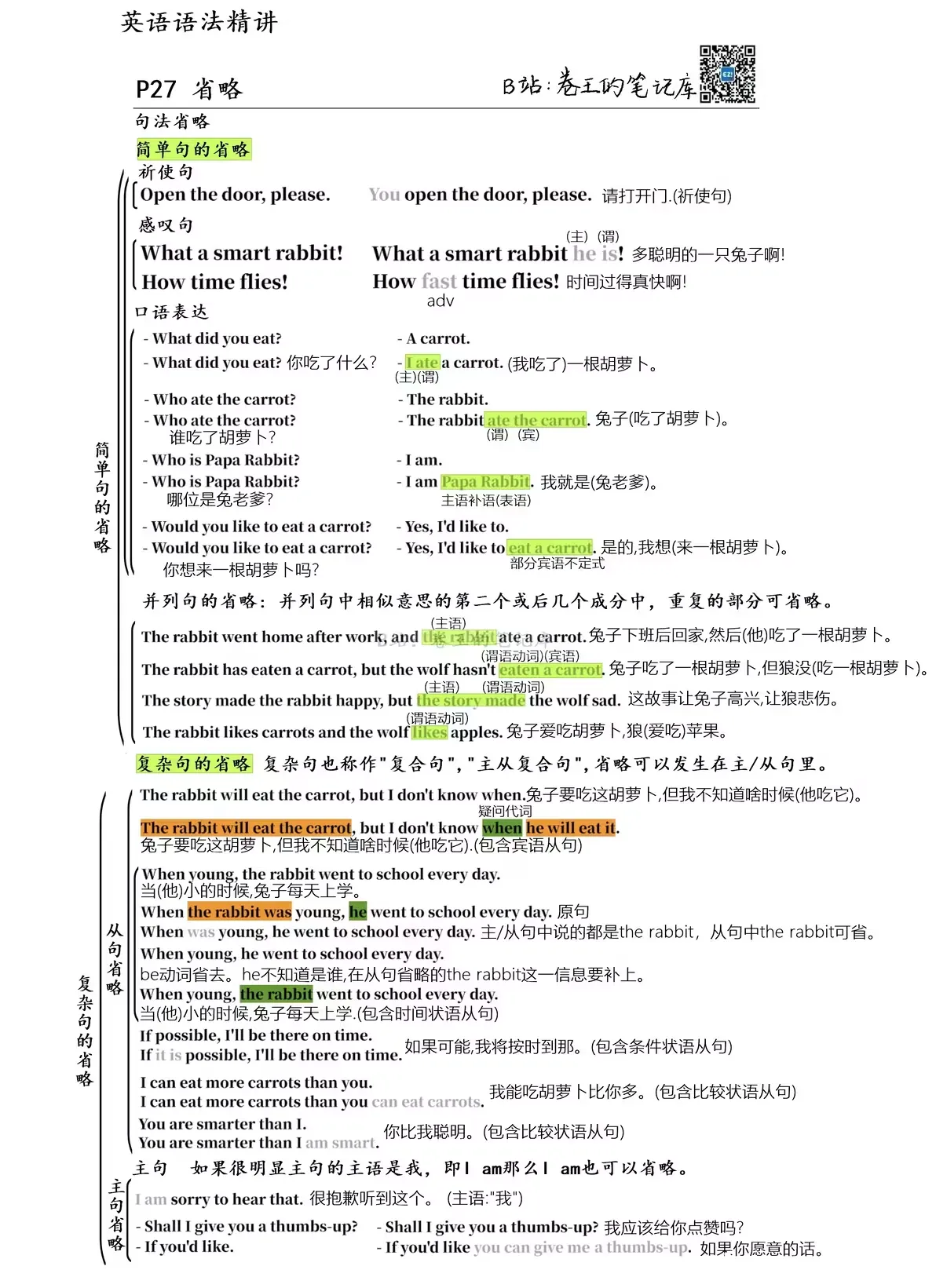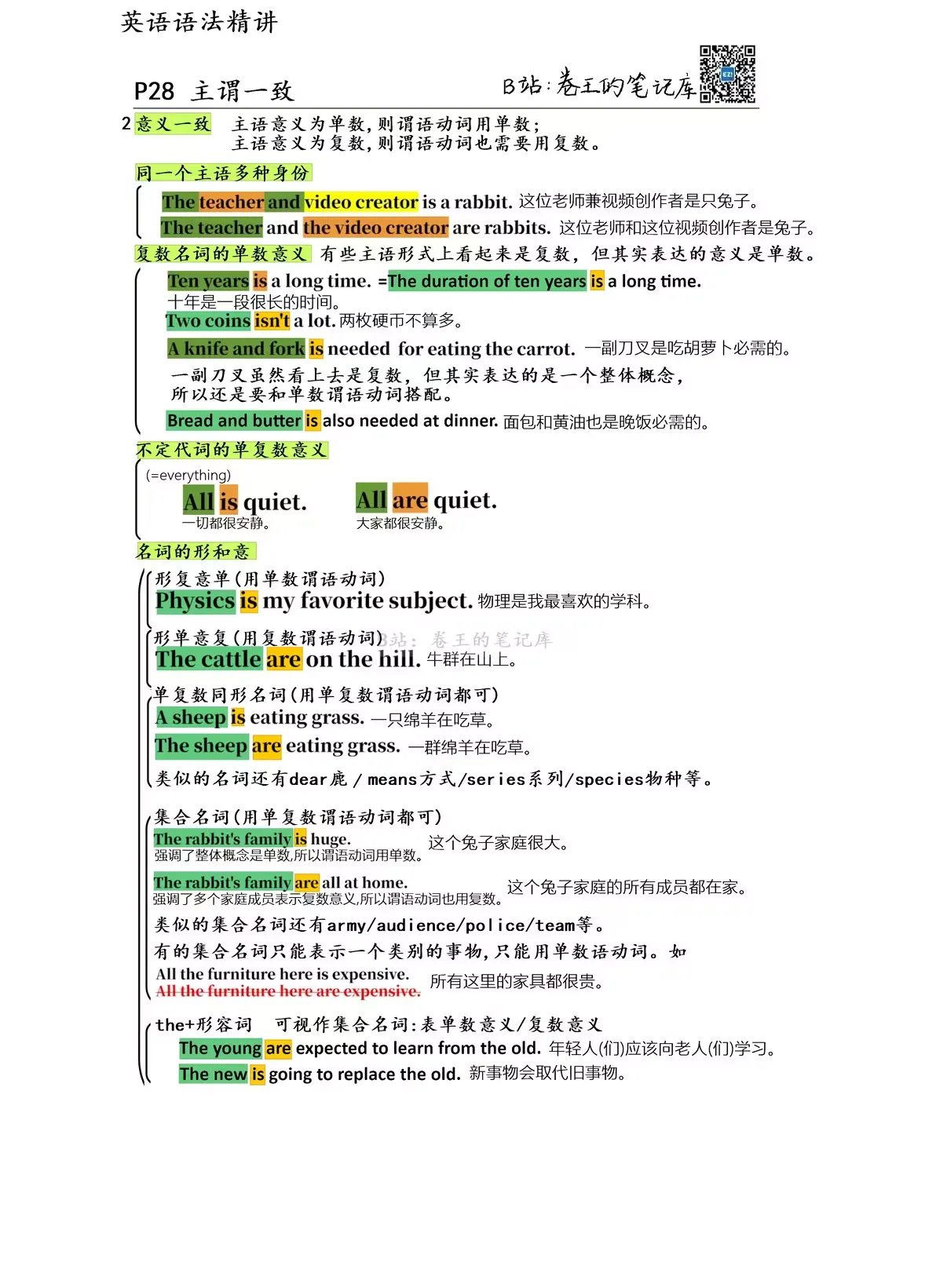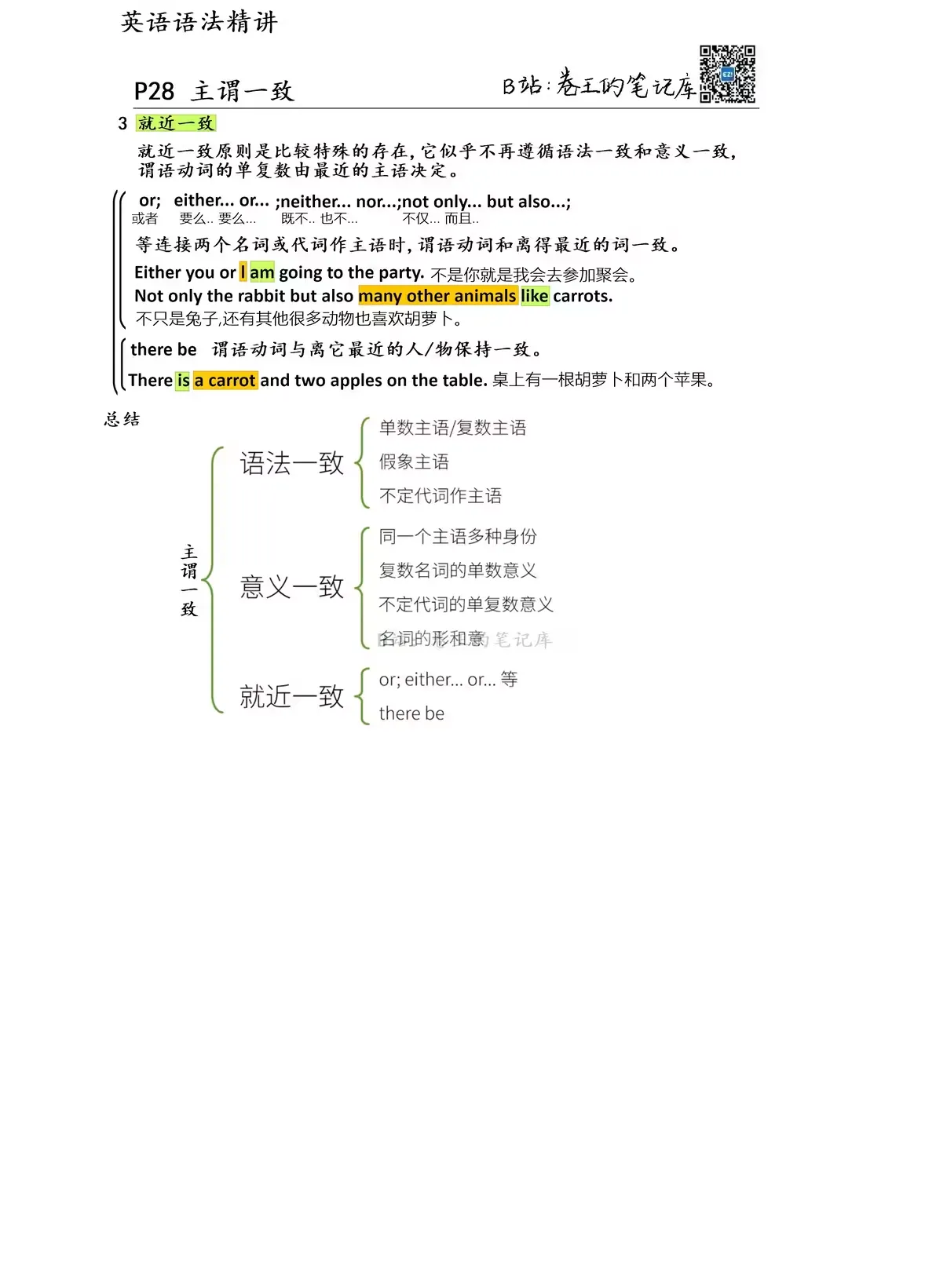被动
一. 英语语态分为两种:主动语态和被动语态
- 根据关注的重点不同,会出现被动和主动两种语态。如在“兔子咬人”和“谁被兔子咬”中,
- 前一句强调动作的执行者兔子,是主动语态;
- 后一句强调动作的承受者,是被动语态。该用被动语态还是主动语态,便可由此区分。
二. 被动语态需要借助谓语动词来构成:
-
主+谓
- The rabbit slept(原型是 sleep,不及物动词,不存在动作承受者,故无被动语态).
- 兔子睡觉
-
主+谓+宾
- The rabbit ate the carrot.
- 如果变成被动语态,就是让动作的承受者 the carrot 变成主语,则首先要调换主语和宾语的位置:
- The carrot ate the rabbit.但是这样显然是有语病的。
- 被动语态的构成一般是”be”+动词过去分词的形式,如果要表明动作的执行者是谁,就要借助”by”+动作执行者。
- 所以正确的改法为:The carrot was eaten by the rabbit.(胡萝卜被兔子吃了)
- 很多时候无需表达被谁这一概念,如:
- A carrot was eaten.
- 通过这里,可以将前述过去分词作表语理解为:
- The rabbit was frightened (by the wolf).(兔子害怕,是被狼吓的)
-
主+谓+宾+宾
- The rabbit gave the carrot to the wolf.
- 这个句子中有两个宾语,分别是直接宾语 the carrot 和间接宾语 wolf,如果强调间接宾语 the wolf:
- The wolf was given the carrot by the rabbit.
- 如果强调直接宾语 the carrot:
- The carrot was given to the wolf by the rabbit.
- 如果都知道兔子给狼胡萝卜,就可以把 by+动作执行者这部分去掉,所以上面两个句子可
- 以简写成:
- The wolf was given the carrot.
- The carrot was given to the wolf.
- 如果这个句子的主动形式写成主语+谓语+直接宾语+间接宾语的形式,那么 to 就消失了:
- The rabbit give the wolf the carrot.
- 但是在强调 the carrot 的被动句时,不能是 the carrot was given the wolf,它和之前的带介词 to 的主动句变被动语态是一样的,所以应该还是:
- The carrot was given to the wolf (by the rabbit).
-
主+谓+宾+宾补
- The wolf invited the rabbit to her party.
- 改为被动态:The rabbit was invited to the party by the wolf.
- 有时需要特别注意:The rabbit made the wolf (to)laugh.(made 后接的是省略了动词不定式的 laugh,所以原句上实际相当于加 to 之后的句子)
- 像上面这种省略了 to 的动词不定式作宾语补语,改成被动语态时要把 to 还原:
- The wolf was made to laugh (by the rabbit).
-
主+系+表语
- The rabbit is smart.
- 很明显,这种句型无法变成被动语态。
三. 如果被动态和时态,语气,情态助词相结合的话,就会产生一系列”化学反应“,如:
- The carrot has been eaten by the rabbit.
- The carrot has not been eaten by the rabbit.
- Has the carrot been eaten by the rabbit?
- The carrot would not have been eaten by the rabbit.
- The carrot would have been eaten by the rabbit.
- Would the carrot have been eaten by the rabbit?
- The carrot might be eaten by the rabbit.
- The carrot might not be eaten by the rabbit.
- Might the carrot be eaten by the rabbit?
强调



省略


主谓一致



从句
形容词从句、定语从句、关系从句都是一个概念,只不过叫法不同而已。 名词从句 > 主语从句 > 限定性从句,他们并不是同一层次上的概念。
英语从句的原理
- The rabbit ate a carrot.
- I saw that the rabbit ate a carrot. (宾语从句,主语和谓语动词分别是”我“和”看见“,而宾语则变成了能单独成句的”兔子吃了根胡萝卜“,that the rabbit ate a carrot 就是一个大宾语,就是所谓的宾语从句。)
在英语中,一个句子 A 可以成为一个整句的某种句子成分。可以理解为:A 成了整句其余部分 B 的附属,服”从“B,同时也无法独立成句。而 B 就成了 A 的”主“人,这就是英语从句的原理。A 就是所谓从句(subordinate clause),B 就是所谓主句(main clause)。他们合在一起是一句复杂句。
- 简单句,保持句意的最短句子,不可再拆。
- 复合句(并列复合句),不分主次,通过连词连接。
- 复杂句(主从复合句),分主次,一个主句,一个从句。从句充当某种成分。
英语从句的分类
- 主语从句、宾语从句、表语从句、宾语补语从句、同位语从句,一般都相当一个”大名词“,全称为名词(性)从句。
- 定语从句被称作形容词(性)从句。定语从句往往会用到一些关系词,所以也被称为”关系从句“。
- 状语从句被称作副词(性)从句,分为:时间、地点、条件、原因、方式、比较…状语从句。
形容词从句
- 对某个人或事物进行描述,具有形容词的性质,所以被称作形容词从句
- 因其往往充当定语成分,所以也被称作定语从句。
形容词从句的思维方式
- The rabbit is eating a carrot that I bought.
- 中文无论何时, 定语都是放在被修饰的名词/代词之前(如这里的胡萝卜),如: 兔子吃了我买的胡萝卜
英文中,单个形容词(或多个形容词,或副词加形容词)作定语, 也是放在被修饰词之前,如:a tasty carrot
英语从句作定语,都是后置的,如:
- a teacher who is a rabbit
- a teacher whom I saw yesterday
- the place where the rabbit ate the carrot
- the reason why the rabbit ate the carrot
- the reason why the rabbit ate the carrot
- a carrot that the rabbit ate
英语中可以理解为:在被修饰的词之后,添加另一个和它有关系的词(如 that),然后再把这个新词放到另一个句子中进行补充说明/逻辑阐述.
语法上,把 that 这类词叫做”关系词“,他之前的被修饰的词(如句里的 carrot,叫做”先行词“)。这里的”另一个句子“就是”定语从句/形容词从句“,而因为其中包含”关系词“的缘故,这样的从句也被称作关系从句。形容词从句/定语从句/关系从句是同一种从句,不要混淆
形容词从句的构成
- 关系词可以分为关系代词和关系副词两类。
- 关系代词
- The rabbit is eating a carrot that I bought
- The teacher who ate a carrot is a rabbit
- The teacher whom I saw yesterday is a rabbit
- The teacher whose favorite food is carrot is a rabbit
- The food which the teacher likes is carrot. (which the teacher likes 做定语)
先行词是唯一的:that 先行词多选一:which 如: The rabbit ate the largest carrot that I’ve ever seen
- all the rabbits that ate a carrot
- the only rabbit that ate a carrot
- the first rabbit that ate a carrot
- 上述几句中,largest,all,only,first 表明了很明确的对象,没有多余的选择,这时就要用 that.
- 关系副词
- where the rabbit ate the carrot 修饰 place,
- why the rabbit ate the carrot 修饰 reason,
- when the rabbit ate the carrot for the first time 修饰 day.
我们也可以把这些关系副词转为关系代词: 关系副词相当于介词+关系代词 which
- This was the place at which the rabbit ate the carrot
- This is the reason for which the rabbit ate the carrot
- That was the day on which the rabbit ate the carrot for the first time
- 限定性和非限定性
-
限定性形容词从句
- 定语从句的主要功能是限定范围,如:
- The rabbit ate the carrot which was on the table.
- 这里的从句限定了 carrot 的范围/性质,言下之意是有好多胡萝卜,但是这兔子吃的只是其中的一根——在桌子上的那一根
- 这样的形容词从句属于限定性从句
-
非限定性形容词从句
-
The rabbit ate the carrot, which was on the table.
-
这句话相当于 The rabbit ate the carrot,the carot was on the table.
-
可以理解为——连续说两次 carrot 太啰嗦,用一个代词 which 替代,避免重复。也就是说,
-
这样的从句压根就没有限定的作用,因为只不过是用了个代词 which 接着说话而已。其实就是一前一后表达了两个信息:兔子吃胡萝卜和胡萝卜在桌上,言下之意是——完全可能只有一根胡萝卜,补充信息是——这根胡萝卜恰巧在桌上而已。
-
I have a head which is round.
-
I have a head, which is round.
-
第一句的言下之意是我有好几个头,其中一个是圆的,其他的头可能是方的扁的。
-
第二句就比较清楚,我有一个头,而我这个头是圆的。
-
即限定性从句的话先行词有一个范围,而这个范围通过限定性从句限定缩小;而非限定性从句本身就指向明确,不需要从句再去限定,而是进行一个补充说明。
-
正因为非限定形容词从句的”非限定的,接着补充的特性“,所以往往用来做句子的插入语,如:
-
My head,
which is big,is useful when it rains -
我有大头,下雨不愁
-
The biggest carrot,
which the rabbit ate,was on the table. -
这两个作插入语的从句都可以直接去掉,且不影响句意:
-
而正因为只是补充信息,所以前面加 the biggest 这样的”确定唯一“的限定词一点问题都没有。但是却不能这样说:
-
The biggest carrot which the rabbit ate was on the table.(×)
-
这样就变成限定性定语从句的形式,which 就和前面的 the biggest 冲突了。非限定性从句更厉害的是不一定是补充某个先行词,而是可以指代整句话,如:
-
The rabbit ate the carrot, which was not surprising.
-
兔子吃了胡萝卜,这事儿不令人吃惊
-
这里是指代前面整句话,表示兔子吃胡萝卜这事儿不令人吃惊,
-
- 名词从句
-
名词从句包括:主语从句,宾语从句,表语从句,同位语从句,宾语补语从句。
-
主语从句的原理
- That the rabbit ate a carrot(that 引导的主语从句)is obvious.
- 引导词 that 在这里是一个从属连词,它也是一个从句开始的信号。中文因为往往没有引导词,所以翻译这句话一般为:兔子吃了胡萝卜这件事儿是明显的。或兔子吃了胡萝卜,这是明显的。
- 所以说白了主语从句就是兔子主语由从句充当,而其他成分该怎么来就怎么来。
- 这个主语从句表达了一个很确定的信息,即”兔子吃了胡萝卜“,但其实不确定的信息也可以构成主语从句,如
- Whether the rabbit ate the carrot is obvious
- Where the rabbit ate the carrot is obvious
- When the rabbit ate the carrot is obvious
- How the rabbit ate the carrot is obvious
- Who ate the carrot is obvious
- What the rabbit ate is obvious
中英的区别就在于:主语从句需要引导词开头,这些引导词都是像 what,where,when 这样的代词/副词,它们如果出现在问句中,被叫做”疑问代词/疑问副词“,而这里用来引导从句,作从句的引导词,属于”连接代词/连接副词“,而从句除去引导词,剩下的语序和中文是基本一致的。
-
形式主语
-
在主语从句的结构中,开头的主语有时会过于冗长,会导致说了很久关键信息才出来。如:
-
That the hungry rabbit had already eaten a carrot for dinner this evening is obvious.
-
这样的话会把真正想表达的意思在很后面才表达出来,有点头重脚轻,而英语母语人士一般这样表达:
-
It is obvious that the hungry rabbit had already eaten a carrot for dinner this evening.
-
那么之前所说的 可以转变为:
-
It is obvious that the rabbit ate a carrot.
-
不能把以上句子翻译为它很明显…
-
如果形式主语 it 指代的内容比较多,我们中文就可以拆句,如:
-
It is obvious that the hungry rabbit had already eaten a carrot for dinner this evening
-
同样的,可以把以下这几句话改为带有形式主语的句子:
-
That the rabbit ate a carrot is a secret -> It is a secret that the rabbit ate a carrot
-
That the rabbit ate a carrot was discussed -> It was discussed that the rabbit ate a carrot
-
That the rabbit ate a carrot happened -> It happened that the rabbit ate a carrot
-
同理,也可将不确定信息的句子改写:
-
It is + 形容词 + that 的结构,在之前的虚拟语气中也出现过,相当于一个主语从句,如:
-
It is suggested that you (should) eat a carrot -> That you (should) eat a carrot is suggested
-
只不过当句子的谓语动词是 suggest,demand,insist,order…这样的词,从句中的动词就要使用动词的虚拟语气,如:
-
It is demanded/insisted/ordered that you (should) eat a carrot.
-
这几个动词的被动态也可以换成某些形容词,照样使用动词虚拟语气,比如:
-
It is important/essential/necessary that you (should) eat a carrot.
-
不过不管是否使用了虚拟语气,这些句子都包含了主语从句。
-
宾语从句
宾语从句就是从句在整个复杂句中做宾语。
- 确定信息&不确定信息
- 宾语从句可能包含确定信息,也可能包含不确定信息
- I saw that the rabbit ate a carrot.
- 其中的 that the rabbit ate a carrot 就是一个宾语从句,作动词 saw 的直接宾语,这里的 that the rabbit ate a carrot 就是一个确定信息。
- 不确定信息作宾语从句和主语从句一样,不确定信息也可以作从句,充当句子的宾语:
- whether the rabbit ate the carrot is obvious
- where the rabbit ate the carrot is obvious
- when the rabbit ate the carrot is obvious
- how the rabbit ate the carrot is obvious
- who ate the carrot is obvious
- what the rabbit ate is obvious
注意两点:第一,除了某些介词参与的情况,从句的引导词基本都在从句的开头,而其他的词遵照正常的陈述语序,基本也和中文一致;第二,不要看到了 whether/where/when/how 这样的词就以为看到了包含疑问代词/疑问副词的问句,于是在之后错误地加上助动词。如: You told me whether
doesthe rabbit eat the carrot
- 引导词 that 的省略
- 在口语或非正式书面语中,宾语从句的引导词 that 往往可以省略,如:
- I know (that) the rabbit ate a carrot.中的 that 就可以省略。而正是由于这种省略,会让人忽略从句的存在,从而误认为有两个谓语动词,但这里的 konw 是主句里的动词,而 ate 是从句里的动词。
- 需要注意的是,只有引导词 that 可以省略,而引导词 what/who/which/when/where/how等则不可以省略。也有时引导词 that 不能省略,否则句子会有歧义或语法错误,如:
- I didn’t know that the rabbit ate the carrot and that you saw it.
- 这句话有两个宾语,分别是”that the rabbit ate the carrot“和”that you saw it“两个宾语从句,
- 意思是:其一,我不知道兔子吃了胡萝卜;其二,我不知道你看见了,第一个 that 去掉还好,但是第二个 that 也去掉的话,就可以这样断句:
- (I didn’t know the rabbit ate the carrot)and( you saw it).不再是 I didn’t know you saw it,而是很确定地陈述 you saw it.
- 再比如插入语:I know,just like you do,that the rabbit ate the carrot. 如果去掉 that,会让人一下反应不过来后面是个从句,反而认为这句话有语病。
- 某些词后的宾语从句的否定
- I think (that) the rabbit is smart.
- I believe (that) you will give me some coins.
- I expect (that) you will give this video a thumbs-up.
- 而在作否定时,否定往往加在谓语动词前,而非从句中:
I think (that) the rabbit isn’t smart- I don’t think (that) the rabbit is smart
- 主从时态一致
-
在大多数情况下,宾语从句和主句中的时态要保持一致,比如:
-
I don’t think (that) you’re right
-
如果一句中的一般时要改为过去式,就不能光改主句,这样的话会导致主句描述过去的动作,但是过去的动作包含一般现在时态,会变成此人未卜先知。
-
所以正确的说法是:I didn’t(过去) think (that) you were(过去) right.
-
再比如:I knew (that) the rabbit liked carrots.
-
虽然 like 是一个”习惯性“的动作/行为,但是因为它所在的从句紧跟了过去时间的主句,所以也要用动词过去式 liked.
-
只有”不变“的客观现象才是例外,如:
-
I knew (that) the sun rises in the east
-
如果用 rise 的过去式 rose,就像是在暗示太阳从前从东方升起,但是以后就不一定了。
- be+形容词+that…句型
-
这样的句型往往在归属于宾语从句,同位语从句还是状语从句上有着归类争议
-
I am sure that there’s a carrot on the table
-
I am happy that there’s a carrot on the table
-
I am afraid that there’s no carrot on the table
-
这样的兔子归为宾语从句的理由是:其中的形容词通常都是表达某种看法或者判断,而 that引导的从句相当于看法/判断,尤其是在中文表达中,比如”I’m sure that…“中,我砍的是什么?我确信的就是 that 后面的信息,所以这样的用法,和动作后加承受者很相似:
-
I confirm that there’s a carrot on the table.
-
I like that there’s a carrot on the table.
-
I fear that there’s no carrot on the table.
-
有些人认为这样的句子属于同位语从句,因为
-
I am sure that…=I am sure of the fact that
-
I am happy that=I am happy about the fact that
-
I am afraid that=I am afraid of the fact that…
-
如果这样看,那么 that 引导的从句实际上相当于同位语,这么说有些牵强,因为句中并没有出现 fact 之类的词,所以 that 引导的从句从形式上来看,并不等同于另一个词(即同位语)。
-
还有些人认为,这样的句子是在描述原因,也就是原因状语从句,如:
-
I am happy that there’s a carrot on the table.
-
等于 I am happy because there’s a carrot on the table.
-
综上,这个句型没有定论,但是这里更偏向于宾语从句的归类。对于究竟如何归类,不必过于在意,主要要会用。
表语从句
- I am a rabbit
- The carrot tastes good
表语从句:就是用从句,充当系动词之后的那个表语。
表语从句最常见的系动词就是 be 动词,而表语从句中的引导词也有多种可能性,表语从句往往就是把之前讲过的主语从句移到系动词之后去
-
The secret is that the rabbit ate a carrot
-
这两句话意思大致相同,但有微妙区别,主要体现在要强调的信息。
-
系动词不一定只是 be 动词,也可能是
feel,seem,look,taste...这样的系动词,所以有如下表语从句: -
It seems that the rabbit is hungry.
-
It feels that you’re not telling the truth.
-
这些句子中的 it 是前文所讲的形式主语,没有实际意思,句子真正要表达的意思都在后面的表语从句中。
同位语从句
-
所谓同位语,就是用不同的方式把一句话再说一遍,并用逗号隔开(避免混乱),如:
-
My teacher(主语),Papa Rabbit(同位语),likes carrots.
-
I like my teacher(宾语),Papa Rabbit(同位语).
-
当一个从句来充当同位语时,这个从句就是同位语从句,这样的从句常在句中修饰抽象的名词(抽象的名词不易理解,所以要用另一种方式再进行解释说明),如:
-
The fact (主语)that the rabbit ate the carrot(同位语从句) did not surprise me.
-
兔子吃了胡萝卜这个事实并没让我吃惊。
-
这里用了引导词,易于看出从句从哪里开始,所以并不需要用逗号隔开。
-
注意:中文翻译的次序和英文不同,中文没有引导词这一概念,所以不能说”这个事实兔子吃了胡萝卜并没让我吃惊“。
-
以上这个兔子同位语包含了已知信息,同位语也可以包含未知信息,如:
-
The question whether the rabbit will eat the carrot is on all our minds.
-
I have no idea (宾语)who ate the carrot(同位语).
-
我不知道谁吃了那胡萝卜
-
这里的 who ate the carrot 把宾语 idea 重新定义了一番,还是个同位语从句。
-
将 be + 形容词 + that 句型改为同位语从句便没有前文中所讨论的争议情形,如:
-
I am sure that there’s a carrot on the table.
-
我确定桌上有根胡萝卜
-
I am sure of the fact(宾语) that there’s a carrot on the table(同位语从句).
-
我确定桌上有根胡萝卜这件事儿。
宾语补语从句
主语+复杂及物动词+宾语+(宾语)补语
- 宾语补语从句是跟在如 call,make,consider…等等后面的从句
- You can call me(宾语) what you like(宾语补语从句)
- 你可以随便叫我什么
- My education made me(宾语) who I am today.
- 我的教育成就了今天的我
副词从句
副词从句在句中起到副词的作用,一般补充说明动词,形容词,副词等,从句子成分上讲,它充当了句子的状语,所以副词从句又叫状语从句。副词从句种类很多,大致可以分为以下几类:
时间副词从句
- 在某一时间点之前。引导词:before
- 从句引导词 before,如:
- the rabbit ate a carrot at home before the wolf stopped by
- Before the wolf stopped by, the rabbit ate a carrot at home
- 可像一句中从句在后,也可像二句中从句提前,但是如果从句在主句之前,便要在从句后加上逗号,便于断句
- 在某一时间点 之中(当时)。引导词:when,while,as.如:
- The rabbit was eating a carrot when I reached home
- The rabbit was eating a carrot while I was making video
- I ate a carrot as I made the video
- 三者不同:when 有突然之意,表时间点,如
- when: 时间点, “突然”
- The rabbit was about to eat a carrot at home when the wolf stopped by
- 兔子在家刚要吃胡萝卜的时候(突然)大灰狼来串门了
- while 一般表在一个时间段之内,如:
- The rabbit was eating a carrot while I was making a video.
- as 一般强调同时进行两个动作,如:
- I ate a carrot as I made the video.
- 我一边吃胡萝卜一边做视频
- when: 时间点, “突然”
- 在某一时间点后。引导词:after,如:
- The rabbit ate a carrot (主句)after the wolf stopped by(从句).
- 从之前某一时间点开始算。引导词:since
- 这里是从某时间点算起的时间段,往往暗示对之后有影响,这样的情况,一般用完成时态。
- 如:The rabbit has shared three carrots since the wolf stopped by
- 自从大灰狼来串门, 兔子已经分享了三根胡萝卜了
- The rabbit has not stopped sharing carrots since the wolf stopped by
- 自从大灰狼来串门, 兔子就一直在分享胡萝卜
- 直到某一时间点。引导词:until
- 这里与 when 区分开,无突然之意
- The rabbit waited until the wolf stopped by
- 兔子一直在等, 直到大灰狼来串门
- The rabbit didn’t eat any carrot until the wolf stopped by
- 兔子直到狼来串门才吃了胡萝卜
- 一…就…
- 引导词:as soon as
- 相当于一个动作紧跟着另一个动作发生:
- The rabbit will eat a carrot as soon as the wolf leaves.
- 大灰狼一离开兔子就要吃胡萝卜
- 下次…
- 引导词:next time
- The rabbit will share the biggest carrot the next time the wolf stops by.
- 下次大灰狼来串门,兔子会一起分享最大的胡萝卜。
地点副词从句
引导词:where+”强调形式“(wherever,everywhere,anywhere)来表地点,如:
- The rabbit ate the carrot where he found it.
- 兔子在找到胡萝卜的地方吃了它
地点副词从句和形容词从句的区别:
The rabbit ate the carrot at the place where he found it.
第一句话中的地点副词从句直接等于地点,而第二句话是修饰先行词 place 的。即一个已经交代了没有具体限定的地点。
-
This is where he found the carrot(表语从句).
-
Where he found the carrot(主语从句) is a secret.
-
单纯引导词 where,并不能确定从句的从属类型,而要具体分析。
-
where 的强调形式,和中文类似的词语对应的话就是:wherever 不管哪里;everywhere 任何地方;anywhere 所有地方。如:
- The rabbit will go wherever he can find a carrot.
- 它和”The rabbit will go where he can find a carrot”这句话很相似,但是前一句的 wherever 强调不管哪里,只要能发现胡萝卜,这兔子就会去。
- 再如: The rabbit sees a carrot everywhere (强调:“任何”地方)he goes.
- The rabbit can eat a carrot anywhere (强调:“所有”地方)he likes.
- 可以理解为等效、相应的定语从句 :
- The rabbit sees a carrot every place where he goes.(定语从句)
- The rabbit can eat a carrot at any place where he likes(定语从句).
比较副词从句
-
He is smarter than me (than做介词, 后接宾格人称代词)
-
This carrot is bigger than that one
-
She is as beautiful as Snow white
-
He is smarter than I am
-
This carrot is bigger than that one is
-
She is more beautiful than Sonw White is
-
前三个句子,都可能是省略句或者是口语化用法,他们完整的、正式的形式都是比较副词从句形式
-
后三句都是副词从句,用比较的方式对前面的主句进行补充说明。
-
尤其是第一句话,用代词宾格me,是口语化的形式,正式是 He is smarter than I (am).
-
比较法不不一定非要更怎么样,也可能“同样得”怎样,如:
- He is as smarter as I am
- This carrot is as big as that one is
- She is as beautiful as Snow White is
- 以上句子也可以口语化, 将be动词省略, 像I am这种形式, 可以省略为单独一个宾格me
-
the+比较级…+the+比较级,如:
- The more you practice English, the more fluent you become
条件副词从句
-
即通常说的“条件句”,如:
- If the rabbit sees(三单形式,主语是第三人称单数时用的) a carrot,he will eat it.这句话等于:
- The rabbit will eat the carrot if he sees it.
- 这个条件只是单纯的假设,属于“真实条件句”,
-
而虚拟语气中则是“虚拟条件句”,其中的条件是和事实相反的假设。如:
- If I saw a carrot, I would eat it.
- If I had seen a carrot, I would have eaten it.
- 这两句是使用了动词虚拟语气的条件副词从句。
-
“主将从现”:主句用将来时态,从句用现在时态。如:
- If the rabbit sees a carrot, he will eat it.
- The rabbit will eat the carrot if he sees it
- 两句中,if 引导了从句,使用的是一般现在时态。
-
但是主将从现并不适用于所有句子:
- If I saw a carrot, I would eat it.
- If I had seen a carrot, I would have eaten it.
- 这里两句分别是主过去将来,从过去和主过去将来完成,从过去完成。
主将从现中的”现”:一般现在时态的重点不是现在这个时间,而是“一般“这个状态,即简单的,默认的,普通的状态。如:
Rabbits eat carrots.
The sun rises in the east.
一般现在时态最常见的情况就是表达习惯/客观事实,其中没有特别指出状态,虽被称作”一般现在时”,却和”现在“没多大关系。如果要说现在正在进行的动作,就要有明确的现在进行时态:
The rabbit is eating a carrot.
The sun is rising above the earth. -
If I see a carrot…中并没有明确的时间信息,英语的”将来“时态指的是非常确定会发生的事儿。
- 如 I will eat a carrot.是确定我将来会吃一根胡萝卜。问题是这个条件不确定是否能形成,
- 所以条件句中只能去掉时间信息,用 一般状态,表达一个”一般的,默认的,普通“的状态。
- 所以这里就用一般现在时态:if I see a carrot.,而不能同样用将来时态:If I will see a carrot.
- 但是,当假设的条件成立时,在这种情况下,”我“一定会去做吃胡萝卜这个动作,所以主句
- 在这种条件成立的情况下,使用一般将来时态,表示明确在将来会发生的动作。
-
进一步从规律上说,条件句总是比主句在时态上落后一个时间段,这也可以应用于虚拟语气:
- If I saw a carrot,I would eat it.
- If I had seen a carrot,I would have eaten it.
- 关于虚拟语气中为什么有过去式和过去分词:虚拟语气条件句中的 saw 并不是在表达时间,
- 不是说明确在过去看见…,而是表达与现实相反的条件。
-
除了 if 可以引导条件副词从句外,unless 也有这个作用:
- If you like this video, you will give it a thumbs-up
- If you don’t like this video, you will not give it a thumbs-up
- 以上的 if 可以换成 unless:
- Unless you like this video, you will not give it a thumbs-up
- 除非你喜欢这个视频, 你不会给他点赞
-
provided, as long as, in case 也可以构成条件副词从句,如:
- Provided that my video is excellent, you will give it a thumbs-up
- As long as I make excellent, you will give it a thumbs-up.
- In case you don’t understand, please comment below.
让步副词从句
-
让步副词从句和条件副词从句还有方式副词从句有相通的地方,都是阐述某种情况,或者做出某种假设,但是其不同之处在于,接下来它会做出一个相反/相对的阐述,最常见的就是:”即使…也…“,所以才有让步一说。如:
- 让步副词从句: Even if I see a carrot, I will not eat it
- 条件副词从句: If I saw a carrot, I would eat it
-
让步的情况不一定是假设,而可能就是事实,如:
- Although I see a carrot,I will not eat it.
- 尽管我看到了根胡萝卜,但我不会吃它。
- 这里的看到胡萝卜是个事实,但是还是让步。
- 而这里的 Although 也可以用 though/even though 来替代,但是要注意,虽然中文有”尽管/虽然…但是…“一说,而英文却不能说:
- although/though/even though…but…
- 至于为什么不能如此,原因如下:
- although/though/even though 本身就引导副词从句,与其后的主句构成复杂句,但是如果加上 but,便不再是复杂句了。
- 用 but 这样的连词能构成一个复合句,如:
- I see a carrot,but I will not eat it.
- 但是要是又用引导词 although,又用连词 but,就会使句子不伦不类。
-
no matter+疑问词形式的让步状语从句
- 上面的让步都是已知情况,而这里的让步是”未知情况“,而 no matter 表不论如何… 如:
- No matter what happens,I will not eat the carrot.
- No matter who orders me,I will not eat the carrot.
- No matter how hungry I am,I will not eat the carrot.
- no matter 也可以用 regardless of 来取代,如:Regardless of what kind of video I make, you will give it a thumbs-up.
方式副词从句
最常见的是两种“方式”:
-
假想的方式
- I feel good as if I had just eaten a carrot
- If I had eaten a carrot, I would have felt good
- 第一句中的好像是在做一个与过去相反的假设,这里跟虚拟语气有些相像,但是他们也有微妙的区别:
- 这里的方式副词从句的主句直接就交代了某种情况,然后用从句交待一个与事实相反的假设,
- 但是不管怎么样,那种情况已经发生了,即 I feel good 是确认的情况,
- 而在虚拟语气中,因为假设的条件与实事相反,而事实并不是已经确定的情况。再比如:
- You spend (so much) money as if you were a millinarire
- if you were a millinarire, you would spend a lot of money
- 第一句是花钱的气派像百万富翁,但其实并不是;第二句是如果是百万富翁会像百万富翁一样花钱,但其实也不是,但要注意区分二者不同。
-
并非假想的方式
- Eat the carrot as I do.
- Leave the carrot asit is.
- 别动这胡萝卜(让胡萝卜如原本那样,别碰它)
- 这样的方式副词从句中,虽然也描述了某种情况,但是并不是假设,而是某种事实的阐述。
- 可以理解为“正在”发生的某种方式。
- 可以把之前的方式状语从句真的用包含了“方式”这个词的,即 The way 的形容词从句来表达。
- You spend money the way (in which) millionaires do.
- Eat the carrot the way (in which) I eat it.
- 由此可知,要表达意思,往往可以用不同类型的从句,只不过有些听上去更常用,更自然,更简洁。
原因副词从句、目的副词从句、结果副词从句
他们有共通点:都是表达了某种因果,即 A 导致 B 这样的情况
-
原因副词从句
-
The rabbit ate the carrot because he was hungry.
-
英文中也不能像中文那样因为…所以…,这和之前解释的 although 和 but 不能连用一个道理。
-
because 引导从句,所以主句前什么也不用加,构成一个复杂句。
-
而 so 是用来构成一个复合句的连词,如:
-
The rabbit was hungry,so he ate the carrot.
-
除了 because 构成原因副词从句,还能用 since 和 as。
- Since you are hungry,you can eat the carrot.
- 既然你饿了,你可以吃这胡萝卜。
这里的 since 不是时间副词, 表从某个时间点开始,而是表示原因。
- As you were not here, we ate the carrot without you.
- 因为你之前不在这,所以吃胡萝卜没带你一个。
这里的 as 也是表原因,并不表“就像”的意思。
-
because,as,since 的区别:
- 第一,从因果/语气的程度上说:because > since > as.
- because 引出的是实实在在的因果关系;
- since 则引出的是大家都已经知道的情况;
- as 引出的是显而易见的事实
- Because this video is excellent, you should give it a thumbs-up
- Since all my videos are excellent, you should give this video a thumbs-up
- As I have thick skin, I’m begging you for a thumbs-up
- 第二,就是语序的区别:
- because 引导的从句,在主句前后都可以;
- 而 since,as 引导的从句一般只能放在主句之前。
- for 这个词也可表一定的因果关系,如:
- You must really like me,for you have given all my videos a thumbs-up.
- 你肯定很喜欢我,因为你给我我所有的视频都点赞了。
- 但是要注意的是:for 构成的不是原因状语从句,for 在这里构成复合句,而不是复杂句。for
- 前和 for 后两句有着同等地位。前者是个推测,而后者补充了推测的原因
- 一个以因推果,一个以果推因。
- 不可以理解为“for 可以替换 because,只不过语气弱一点而已”
- 第一,从因果/语气的程度上说:because > since > as.
-
-
目的副词从句
- 因为要达到目的 A(从句),所以做了 B(主句),或者说,之所以做 B(主句),是为了达到目的 A(从句)。如:
- In order that I could finish the video in time(目的A), I pulled an all-nighter(事件B 主句)
- 为了及时完成视频, 我熬夜不睡
- 这句基本等于: I pulled an all-nighter so that I could finish the video in time
- 注意: so that 不可以放在句首. 且目的副词从句中, 一般使用情态助词 can could mat might should would等, 因为这样能更好体现目的性
-
结果状语从句
-
结果状语从句也可以由 so that 构成
- I ate a lot of carrots for lunch so that I wasn’t hungry at all in the afternoon
- 与 so that 引导的目的状语从句的区别在于一个后面跟前句导致的结果,以前句为主动;
- 一个后句说明目的/原因,从而导致做出前句的行为,以后句为主动。再如:
- The temperature was low so that the lake froze
- 这样的句子只能用结果来解释。
- so 也表示“因此是;结果是”,如:
- I like this video,so I’ll give it a thumbs-up.
- 他跟 so that 的区别也在于一个引导从句组成复杂句,一个连接并列句,组成复合句,
-
so that 可以分开用,成为 so+形容词+…that…,,如:
- I ate so many carrots for lunch that I felt sick afterwards
- 或者也可以用 such…that…,但是其与 so…that…有区别,sunch 后要跟名词或名词性成分
- It was such a tasty a carrot that I ate it all at once
- 而非形容词,如果坚持要用 so,也不是不可以,如:
- It was so tasty a carrot that I ate it all at once
-